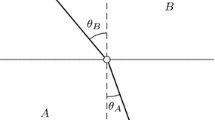Abstract
Define a design to be any planar setD of known areaa, but of unknown shape and location; more generally, a design can be any set inR d of measurea. For example, a design might be one floor of a warehouse, or a sports arena of known seating capacity. Suppose that the design has, say,m users, or evaluators, with user/evaluatori having a design disutility functionu i , 1≤i≤m, which can be defined for all points in the plane independently of the designs of interest. Given any designD, denote byG i (D) the disutility ofD to user/evaluatori where, by definition,G i (D) is the supremum ofu i over the setD, 1≤i≤m. LetG(D) be the vector with entriesG i (D), 1≤i≤m, and define a design to be efficient if it solves the vector minimization problem obtained using the set of vectors {G(D):D a design}. Given mild assumptions about the disutility functions, and a slight refinement of the design definition to rule out certain pathologies, we present necessary and sufficient conditions for a design to be efficient, and study properties of efficient designs. In the final section, we extend the analysis to more generall p -measures of design disutility.
Similar content being viewed by others
References
Keeney, R. L., andRaiffa, H.,Decisions with Multiple Objectives: Preferences and Trade-Offs, John Wiley and Sons, New York, New York, 1976.
Francis, R. L.,Sufficient Conditions for Some Optimum-Property Facility Designs, Operations Research, Vol. 15, pp. 448–466, 1967.
Kottas, J. F.,Spectator Seating Preference as a Determinant in Design and Pricing Decisions, Design Methods and Theories, Vol. 11, pp. 91–97, 1977.
Chalmet, L. G., Francis, R. L., andLawrence, J. F.,Efficiency in Integral Facility Design Problems, Journal of Optimization Theory and Applications, Vol. 32, No. 2, 1980.
Francis, R. L., andWhite, J. A.,Facilities Layout and Location: An Analytical Approach, Prentice-Hall, Englewood Cliffs, New Jersey, 1974.
Royden, H. L.,Real Analysis, The Macmillan Company, New York, New York, 1963.
Hall, D. W., andSpencer, G. L.,Elementary Topology, John Wiley and Sons, New York, New York, 1959.
Author information
Authors and Affiliations
Additional information
Communicated by P. L. Yu
This research was supported in part by the Interuniversity College for PhD studies in Management Sciences, Brussels, Belgium; by the Army Research Office, Triangle Park, North Carolina; by a National Academy of Sciences-National Research Council Postdoctorate Associateship; and by the Operations Research Division, National Bureau of Standards, Washington, DC. The authors would like to thank Dr. A. J. Goldman for his many constructive suggestions, and Dr. A. Veinott for suggesting the problems considered in Section 3.
Rights and permissions
About this article
Cite this article
Chalmet, L.G., Francis, R.L. & Lawrence, J.F. On characterizing supremum andl p -efficient facility designs. J Optim Theory Appl 35, 129–141 (1981). https://doi.org/10.1007/BF00934708
Issue Date:
DOI: https://doi.org/10.1007/BF00934708




